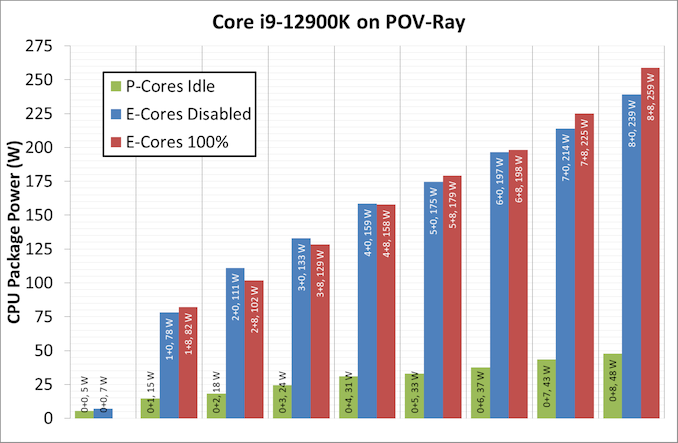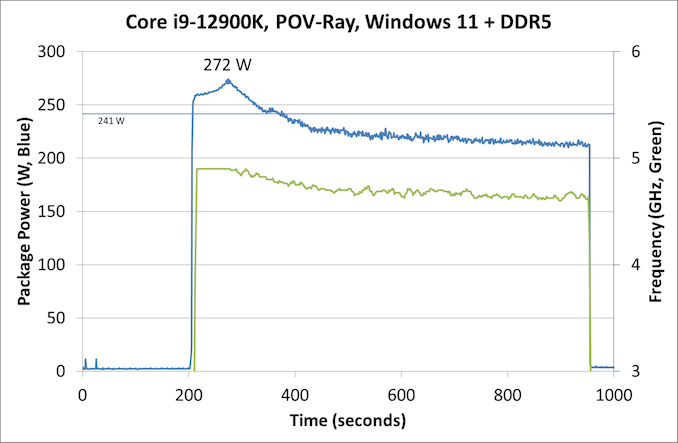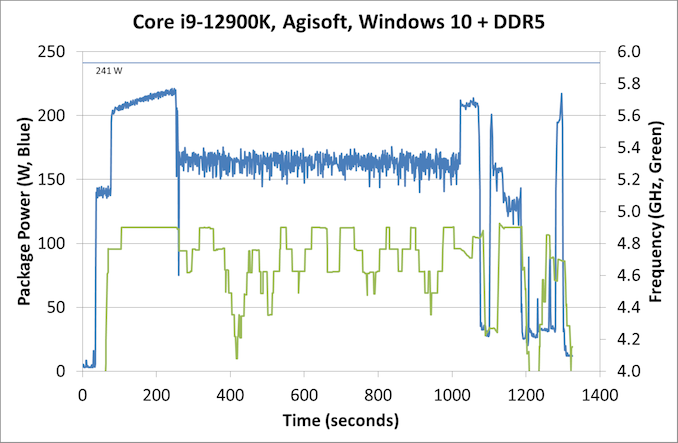The Intel 12th Gen Core i9-12900K Review: Hybrid Performance Brings Hybrid Complexity
by Dr. Ian Cutress & Andrei Frumusanu on November 4, 2021 9:00 AM ESTPower: P-Core vs E-Core, Win10 vs Win11
For Alder Lake, Intel brings two new things into the mix when we start talking about power.
First is what we’ve already talked about, the new P-core and E-core, each with different levels of performance per watt and targeted at different sorts of workloads. While the P-cores are expected to mimic previous generations of Intel processors, the E-cores should offer an interesting look into how low power operation might work on these systems and in future mobile systems.
The second element is how Intel is describing power. Rather than simply quote a ‘TDP’, or Thermal Design Power, Intel has decided (with much rejoicing) to start putting two numbers next to each processor, one for the base processor power and one for maximum turbo processor power, which we’ll call Base and Turbo. The idea is that the Base power mimics the TDP value we had before – it’s the power at which the all-core base frequency is guaranteed to. The Turbo power indicates the highest power level that should be observed in normal power virus (usually defined as something causing 90-95% of the CPU to continually switch) situation. There is usually a weighted time factor that limits how long a processor can remain in its Turbo state for slowly reeling back, but for the K processors Intel has made that time factor effectively infinite – with the right cooling, these processors should be able to use their Turbo power all day, all week, and all year.
So with that in mind, let’s start simply looking at the individual P-cores and E-cores.
Listed in red, in this test, all 8P+8E cores fully loaded (on DDR5), we get a CPU package power of 259 W. The progression from idle to load is steady, although there is a big jump from idle to single core. When one core is loaded, we go from 7 W to 78 W, which is a big 71 W jump. Because this is package power (the output for core power had some issues), this does include firing up the ring, the L3 cache, and the DRAM controller, but even if that makes 20% of the difference, we’re still looking at ~55-60 W enabled for a single core. By comparison, for our single thread SPEC power testing on Linux, we see a more modest 25-30W per core, which we put down to POV-Ray’s instruction density.
By contrast, in green, the E-cores only jump from 5 W to 15 W when a single core is active, and that is the same number as we see on SPEC power testing. Using all the E-cores, at 3.9 GHz, brings the package power up to 48 W total.
It is worth noting that there are differences between the blue bars (P-cores only) and the red bars (all cores, with E-cores loaded all the time), and that sometimes the blue bar consumes more power than the red bar. Our blue bar tests were done with E-cores disabled in the BIOS, which means that there might be more leeway in balancing a workload across a smaller number of cores, allowing for higher power. However as everything ramps up, the advantage swings the other way it seems. It’s a bit odd to see this behavior.
Moving on to individual testing, and here’s a look at a power trace of POV-Ray in Windows 11:
Here we’re seeing a higher spike in power, up to 272 W now, with the system at 4.9 GHz all-core. Interestingly enough, we see a decrease of power through the 241 W Turbo Power limit, and it settles around 225 W, with the reported frequency actually dropping to between 4.7-4.8 GHz instead. Technically this all-core is meant to take into account some of the E-cores, so this might be a case of the workload distributing itself and finding the best performance/power point when it comes to instruction mix, cache mix, and IO requirements. However, it takes a good 3-5 minutes to get there, if that’s the case.
Intrigued by this, I looked at how some of our other tests did between different operating systems. Enter Agisoft:
Between Windows 10 and Windows 11, the traces look near identical. The actual run time was 5 seconds faster on Windows 11 out of 20 minutes, so 0.4% faster, which we would consider run-to-run variation. The peaks and spikes look barely higher in Windows 11, and the frequency trace in Windows 11 looks a little more consistent, but overall they’re practically the same.
For our usual power graphs, we get something like this, and we’ll also add in the AVX-512 numbers from that page:

Compared to Intel’s previous 11th Generation Processor, the Alder Lake Core i9 uses more power during AVX2, but is actually lower in AVX-512. The difficulty of presenting this graph in the future is based on those E-cores; they're more efficient, and as you’ll see in the results later. Even on AVX-512, Alder Lake pulls out a performance lead using 50 W fewer than 11th Gen.
When we compare it to AMD however, with that 142 W PPT limit that AMD has, Intel is often trailing at a 20-70 W deficit when we’re looking at full load efficiency. That being said, Intel is likely going to argue that in mixed workloads, such as two software programs running where something is on the E-cores, it wants to be the more efficient design.














474 Comments
View All Comments
Kvaern1 - Sunday, November 7, 2021 - link
Because there are no games which are 'incompatible'' with ADL.eastcoast_pete - Sunday, November 7, 2021 - link
While AL is an interesting CPU (regardless of what one's preference is), I still think the star of AL is the Gracemont core (E cores), and did some very simple-minded, back of a napkin calculations. The top AL has 8 (P cores with multithreading) = 16 + 8 E core threads (no multithreading here) for a total of 24 threads. According to first die shots, one P core requires the same die area as 4 E cores. That leaves me wanting an all-E core CPU with the same die size as the i9 AL, because that could fit 8x4= 32 plus the existing 8 Gracemonts, for a total of 40. And, the old problem of "Atoms can't do AVX and AVX2" is solved - because now they can! Yes, single thread performance would be significantly lower, but any workload that can take advantage of many threads should be at least as fast as on the i9. Anyone here knows if Intel is considering that? It wouldn't be the choice for gaming, but for productivity, it might give both the i9 and, possibly, the 5950x a run for the money.mode_13h - Monday, November 8, 2021 - link
They currently make Atom-branded embedded server CPUs with up to 24 cores. This one launched last year, using Tremont cores:https://ark.intel.com/content/www/us/en/ark/produc...
I think you can expect to see a Gracemont-based refresh, possibly with some new product lines expanding into non-embedded markets.
eastcoast_pete - Monday, November 8, 2021 - link
Yes, those Tremont-based CPUs are intended/sold for 5G cell stations; I hope that Intel doesn't just refresh those with Gracemont, but makes a 32-40 Gracemont core CPU available for workstations and servers. The one thing that might prevent that is fear (Intel's) of cannibalizing their Sapphire Rapid sales. However, if I would be in their shoes, I'd worry more about upcoming AMD and multi-core ARM server chips, and sell all the CPUs they can.mode_13h - Tuesday, November 9, 2021 - link
Well, it's a start that Intel is already using these cores in *some* kind of server CPU, no? That suggests they already should have some server-grade RAS features built-in. So, it should be a fairly small step to use them in a high core count CPU to counter the Gravitons and Altras. I think they will, since it should be more competitive in terms of perf/W.As for workstations, I think you'll need to find a workstation board with a server CPU socket. I doubt they'll be pushing massive E-core -only CPUs specifically for workstations, since workstation users also tend to care about single-thread performance.
anemusek - Sunday, November 7, 2021 - link
Sorry but performance it isn't all +- a few percent in the real world will not restore confidence. Critical flaws, disabling functionality (dx12 in hanswell for example), instabbility instruction features etc.I cannot afford to trust such a company
Dolda2000 - Sunday, November 7, 2021 - link
I just wanted to add a big Kudos for this article. AnandTech's coverage of the 12900K was by a wide margin the best of any I read or watched, with regards to coverage of the various variables involved, and with the breadth and depth of testing. Thanks for keeping it up!chantzeleong - Monday, November 8, 2021 - link
I run Power bi and tensorflow with large dataset. Which Intel CPU do you recommend and why?mode_13h - Tuesday, November 9, 2021 - link
I don't know about "Power bi", but Tensorflow should run best on GPUs. Which CPU to get then depends on how many GPUs you're going to use. If >= 3, then Threadripper. Otherwise, go for Alder Lake or Ryzen 5000 series.You'll probably find the best advice among user communities for those specific apps.
velanapontinha - Monday, November 8, 2021 - link
We've seen this before. It is time to short AMD, unfortunately.